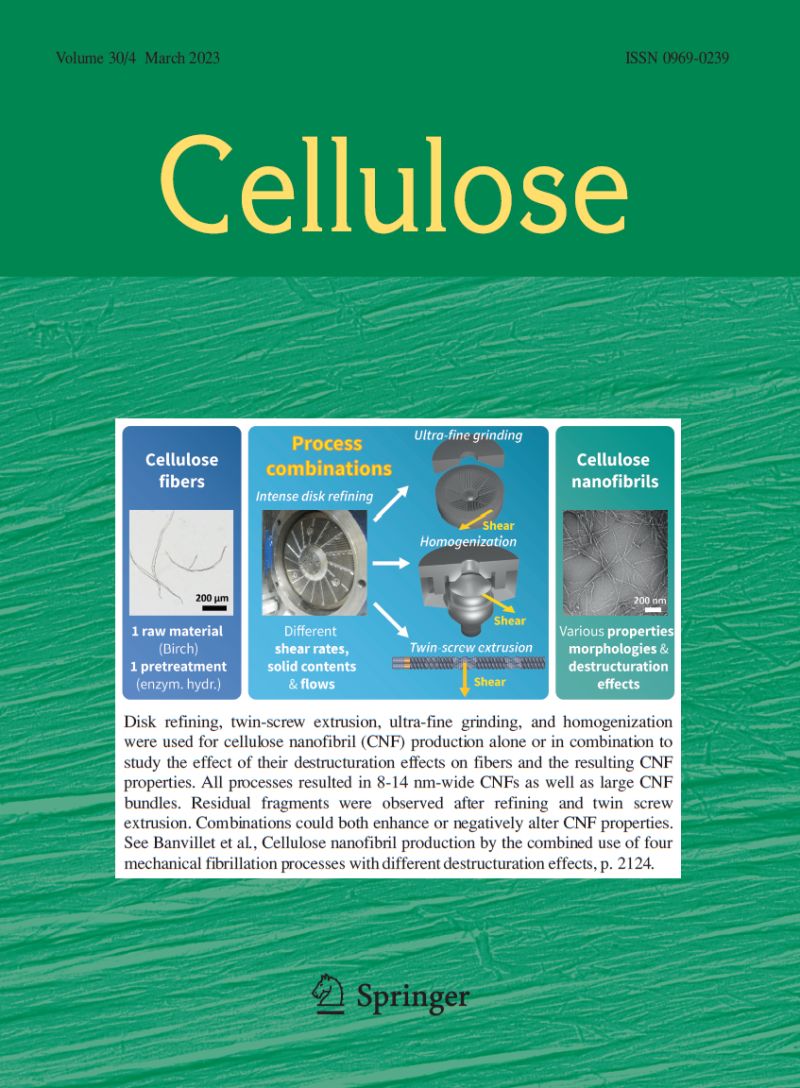纤维素提取法对甘蔗渣的增值作用:提取方法对纤维素增强复合膜性能的影响
摘要
农业废物的增值对促进可持续性、经济增长和环境缓解至关重要。本研究以亨内昆农业废弃物亨内昆甘蔗渣为木质纤维素原料,对其进行纤维素提取,制备纤维素-丙烯酸复合膜。采用碱水热法(AHTP)和碱萃取法(AEP)制备纤维素。从产率、粒度、结晶度和形貌等方面对所得纤维素浆进行了分析。结果表明,AEP法具有较高的效率(43%) and aspect ratio (\(L/D = 73\)), whereas the AHTP method yielded 37% with an aspect ratio of 55. In terms of crystallinity, the AHTP method produced cellulose with 63% crystallinity, exhibiting a cellulose I structure, while the AEP method resulted in 44% crystallinity with a partial conversion from cellulose I to cellulose II. Composites were prepared dispersing cellulose in a commercial acrylic base latex (AF). Thermogravimetric analysis curves showed a single-step degradation at approximately 377 °C for cellulose and 400 °C for AF. The inclusion of cellulose did not affect the thermal stability of AF. Finally, the effect of cellulose incorporation on the mechanical properties of the reinforced material was evaluated. The highest elastic modulus (111 MPa) and ultimate tensile strength (6 MPa) were obtained for the composite reinforced with AHTP-derived cellulose at 10 wt%. However, a significant reduction in elongation at break was observed, decreasing from 435 to 77%.The valorization of agricultural waste is essential for promoting sustainability, economic growth, and environmental mitigation. In this study, henequen bagasse a waste of the henequen agroindustry was utilized as a lignocellulosic material for cellulose extraction and use it in obtaining cellulose–acrylic composite films. Two methods were employed for cellulose obtaining: the alkaline hydrothermal process (AHTP) and the alkaline extraction process (AEP). The resulting cellulose pulp was analyzed in terms of yield, particle size, crystallinity, and morphology. The results indicated that the AEP method yielded a higher efficiency (43%) and aspect ratio (\(L/D = 73\)), whereas the AHTP method yielded 37% with an aspect ratio of 55. In terms of crystallinity, the AHTP method produced cellulose with 63% crystallinity, exhibiting a cellulose I structure, while the AEP method resulted in 44% crystallinity with a partial conversion from cellulose I to cellulose II. Composites were prepared dispersing cellulose in a commercial acrylic base latex (AF). Thermogravimetric analysis curves showed a single-step degradation at approximately 377 °C for cellulose and 400 °C for AF. The inclusion of cellulose did not affect the thermal stability of AF. Finally, the effect of cellulose incorporation on the mechanical properties of the reinforced material was evaluated. The highest elastic modulus (111 MPa) and ultimate tensile strength (6 MPa) were obtained for the composite reinforced with AHTP-derived cellulose at 10 wt%. However, a significant reduction in elongation at break was observed, decreasing from 435 to 77%.

 求助内容:
求助内容: 应助结果提醒方式:
应助结果提醒方式:


